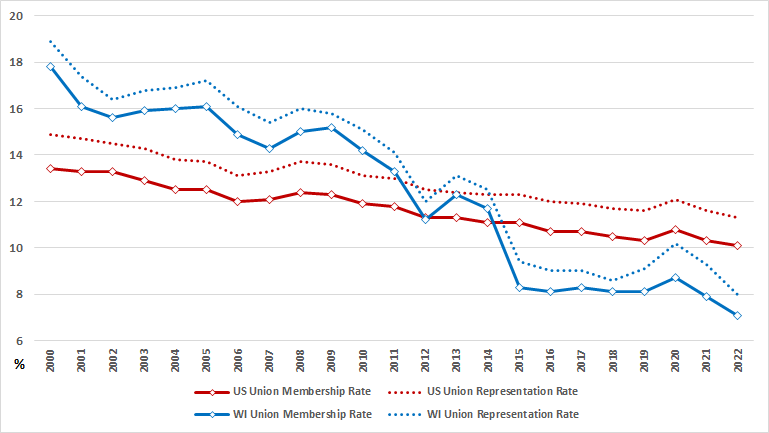Union membership in Wisconsin declined by 28,000 in 2022, dropping below 200,000 for the first time since at least 2000, according to data from the U.S. Bureau of Labor Statistics.
The state had 187,000 union members this past year, down from 215,000 in 2021. The 13% drop in overall membership was the largest since 2015 and nearly matched the 13.6% decline from 2012. The decline also dropped the rate of union membership in the state from 7.9% in 2021 to 7.1%.
Wisconsin has seen a sharp decline in union membership since 2010 with the implementation of Act 10 and right-to-work laws under former Gov. Scott Walker. In 2010, the rate was 14.2% and it had dropped to 11.2% by 2012. By 2015, the rate had declined to 8.3%.
There was an increase in the rate to 8.7% in 2020, driven primarily by a decrease in overall employment.
Worker representation by unions also took a big hit last year, declining by 39,000 from 251,000 to 212,000. At 15.5%, it was the largest decline since the 22.6% drop in 2015 when right-to-work was put in place. The law prevents requiring union membership as a condition of employment.
The rate of union representation declined to 8% in 2022 from 9.3% in 2021.
Nationally, total union membership increased almost 2% to a little less than 14.3 million and union representation was up 1.3% to 16 million.
Membership and representation rates were down two and three tenths of a point to 10.1 and 11.3% respectively as overall employment outpaced union growth.
Wisconsin now ranks 34th in the country for overall union representation, down from 29th in 2021 and 26th in 2020. The state ranked in the low 30s from 2015 to 2018. A little more than a decade ago, Wisconsin was in the top 20 for union representation, ranking 17th in 2010 and 19th in 2011.


